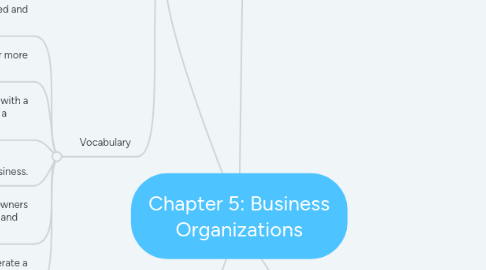
1. Key Concepts
1.1. Designing an effective Business Organization
1.1.1. Responsibility, Authority, and Accountability
1.1.2. Unity of Command
1.1.3. Span of Control
1.2. Types of organizational structures
1.2.1. Functional Organization Structure: Most businesses use a functional organizational structure. In this type of organization, work is arranged within main business functions such as production, operations, marketing, and human resources.
1.2.2. In a matrix organizational structure, work is structured around specific projects, products, or customer groups.
2. 5.2
2.1. Key Concepts: Forms of Business Ownership
2.1.1. Business Ownership Forms
2.1.1.1. There are Partnerships, Corporations, and Proprietorship in business.
2.1.2. Choosing A Form of Business Ownership
2.1.2.1. Sole proprietorship are good for those who want to take risks and have total control over a company
2.1.2.2. Partnerships are more complex then sole proprietorship and have less risk with money invested. However, ownership must be shared.
2.1.3. Other Forms of Ownership
2.1.3.1. Corporations are the largest form of business that usually deal with equity and a board of directors. While someone can be in charge and be a founder, most responsibility is shared here
2.1.3.2. A limited liability partnership identifies some investors who cannot lose more than the amount of their investment, but they are not allowed to participate in the day-to-day management of the business.
2.1.3.3. A joint venture is a unique business organized by two or more other businesses to operate for a limited time and for a specific project. It is a type of partnership.
2.1.3.4. A franchise is a written contract granting permission to operate a business to sell products and services in a set way.
2.2. Vocabulary
2.2.1. Proprietorship: a business owned and run by just one person.
2.2.2. Partnership: a business owned and controlled by two or more people who have entered into a written agreement.
2.2.3. Corporation: a separate legal entity formed by documents filed with a state. It is owned by one or more shareholders and managed by a board of directors.
2.2.4. Articles of incorporation: a written legal document that defines ownership and operating procedures and conditions for the business.
2.2.5. Partnership agreement: a written agreement among all owners detailing the rules and procedures that guide ownership and operations.
2.2.6. Franchise: a written contract granting permission to operate a business to sell products and services in a set way.
3. 5.1
3.1. Key Concepts
3.1.1. U.S Market Fluctuation:
3.1.1.1. 21st century had fluctuating economy due to 9/11
3.1.1.2. Unemployment grew by 6%
3.1.1.3. Ethnic Workers became a bigger part of the economy
3.1.1.4. Pressure on employees grew due to the assumption that technology would decrease the needed work hours in years to come when it did not
3.1.2. Business and the Economy
3.1.2.1. Majority of U.S businesses (21.7 million) are small businesses. 5.8 million employ fewer then 20, and 526,000 employ more then 20
3.1.2.2. Businesses often have large impacts on a community in which it employs workers and deals with other businesses.
3.1.2.3. There are 6 main things when starting up/operating a business: 1. Marketing goods and services. 2. Marketing business records. 3. Generating ideas and business ideas to stay relevant. 4. Obtaining financial resources. 5. Employing and training personnel. 6. Buying goods and services
3.1.3. Types of Businesses
3.1.3.1. Producers
3.1.3.1.1. A type of business that creates goods and services for other businesses or consumers
3.1.3.2. Intermediaries
3.1.3.2.1. Intermediaries are businesses that deal with selling goods and service to other businesses
3.1.3.3. Service Businesses
3.1.3.3.1. Service businesses are businesses that do not make tangible products but rather carry out activities for clients
3.2. Vocabulary
3.2.1. Contingent Worker: one who has no explicit or implicit contract for long-term employment.
3.2.2. Intermediaries: businesses involved in selling the goods and services of producers to consumers and other businesses.
3.2.3. Service Business: a business that carries out activities that are consumed by its customers.
4. 5.3
4.1. Vocabulary
4.1.1. Mission Statement: short, specific written statement of the reason a business exists and what it wants to achieve.
4.1.2. Goal: a precise statement of results the business expects to achieve.
4.1.3. Policies: guidelines used in making consistent decisions.
4.1.4. Procedures: a list of steps to be followed for performing a particular work activity; a description of the way work is to be done.
4.1.5. Organization Chart: a diagram that shows the structure of an organization, classifications of work and jobs, and the relationships among those classifications.

